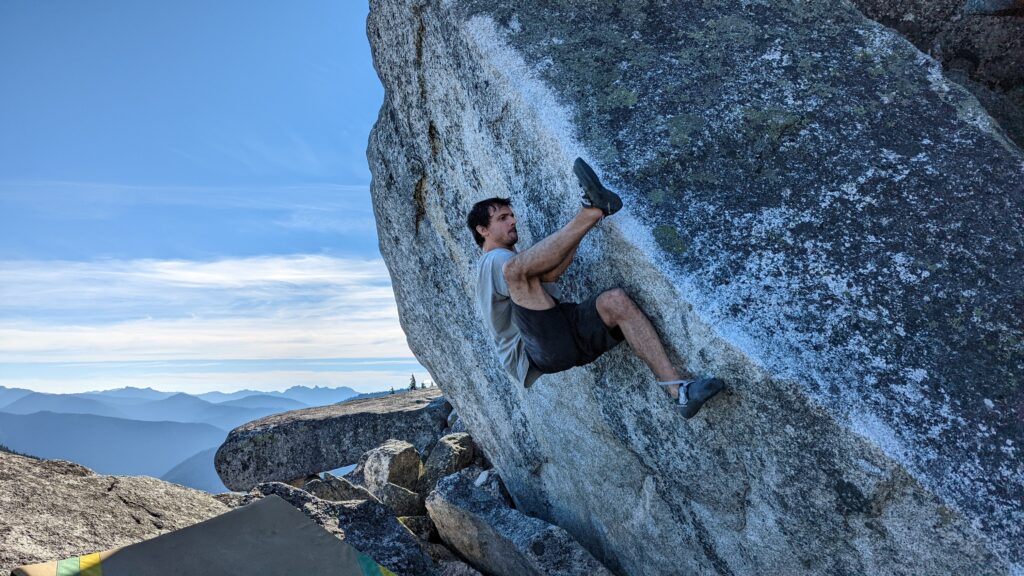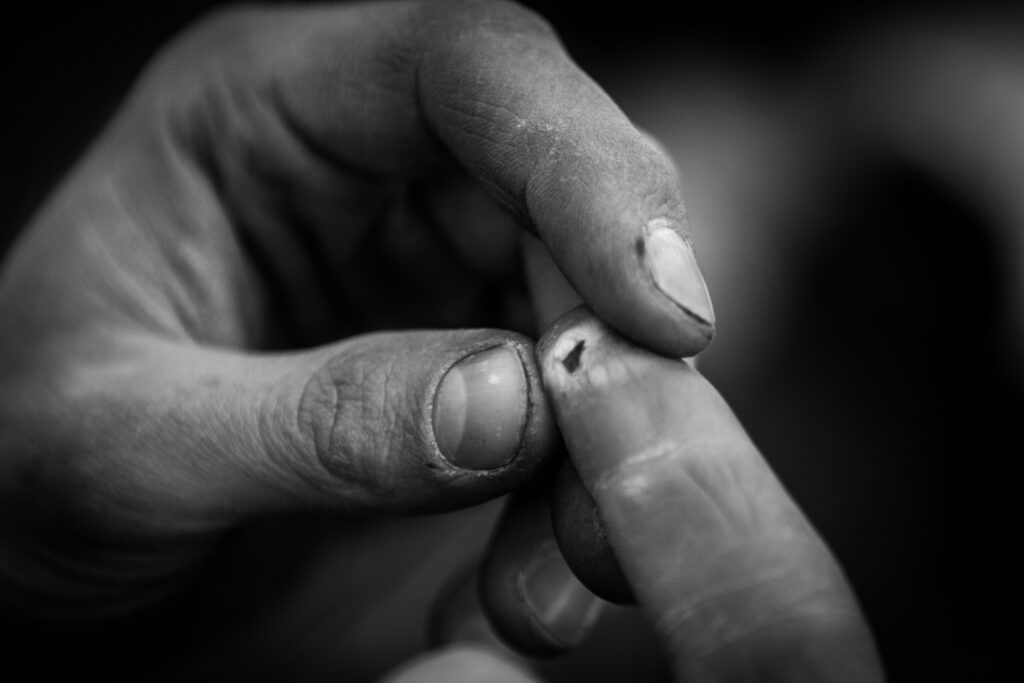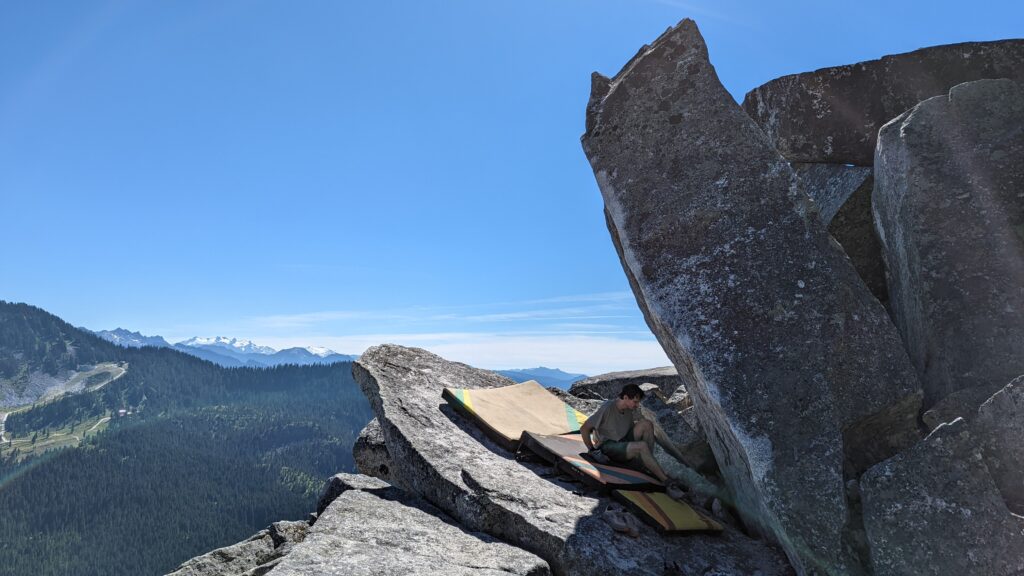“Is it really summer if you don’t get granite rash scrapes on top of your poison oak rash?” my friend Sean joked, while we tried to stuff our things back into our packs without dropping anything essential down the abyssal holes between talus. I had just given up trying our “warmup project.” After thrashing my forearm against the rock forerunning the topout, I decided the skin cost was too high to try again.
I spend much of the work week thinking about what my plans are for the weekend, and obsessing over the weather. I’m excited to meet my friends in the mountains. My thoughts wander ahead, preoccupied with the rat-race-relieving ecstasy of recreational oblivion.
This week, I’d been preoccupied with this gorgeous hunk of stone – the aptly named No More Time.

An imposing, laser-cut monolith that hangs over Steven’s Pass. A true panopticon for the valley below and miles of mountains beyond. I’ve dreamed about this one for ages – I was reading NW Granite, Kelly Sheridan’s old blog, via RSS feed when these areas were being explored almost 15 years ago.
Knowing conditions would be August-grim, and having never been there before, I set my stretch goal to something that felt achievable. I wanted to top out the boulder, in any fashion, from any start, official or otherwise.
My main goal, as it is every climbing day in a new area, was to top out one new boulder problem of any grade. These kind of achievable goals keep my climbing progression bite-size, and help me focus on the process.
On Monday, my body is bruised and abused; I’m more inflamed mosquito bite than human this time of year after the weekend. But my mood is elevated. I’ll spend the next day or two reflecting on the glory of being out there. Is the physical torture worth the emotional catharsis? Or perhaps it brings the catharsis? I’m not sure.
I am sure of this, though: neither looking forward to climbing, nor reflecting on it later, are real life.
While I’m actually out there, climbing, I am frequently miserable. Sure, it’s accompanied by a grin, and a tongue-in-cheek joke about the hike. But it’s suffering nonetheless. That’s real.
Being drenched in sweat, calves burning, while you forge uphill – perfectly perpendicular to the contour lines of the topo map. Being assaulted by hordes of insects. That’s real.
The pain of smashing your days-old skin against ten-million-years-old granite, and the redoubled pain of knowing when that skin has given out on you. Raw flesh just doesn’t have the friction coefficient that actual skin does, no matter how psyched you are. That desperation and bargaining, hours deep in the session – that’s real.
So why bother?

Bill Ramsay, climbing’s version of a philosopher king, likes to bring up the pain box. The idea is, all you can do is choose the source of your pain. You can either have the pain of suffering now to achieve the goal you have in mind, or you can have the suffering later of knowing you didn’t achieve it. Either way, you’re going to experience pain.
On the drive out climbing, I picked up a hitchhiker on his way to the PCT. He was from Denmark, and visiting America to tour around and hike. At first, he thought I was talking about rappelling, and he tried to relate by mentioning that he had done a rope access course at some point and knew how to belay. It took a solid 10 miles of the drive westward for me to explain what bouldering was.
Thinking about the PCT distresses me at first – to have hiked a couple thousand miles from the Sonoran desert all the way to the North Cascades, and not have a single “real” climbing experience along the way! I proffered him the slice of blueberry coffee cake I’d brought for a morning snack out of sheer pity. My God, I thought. All those steps. What a waste of a summer.
But of course, he didn’t see it that way – and I don’t either, clearly. If you put together all the days I didn’t “send” anything “meaningful”, you could stretch the approaches a great distance. My bruises and mosquito bites could paint a vast mural.
Retrospectively, most days aren’t that special. That’s what makes living the ones that are special so damn important. The suffering is a necessary reagent for the formula; the joy of climbing is a snake eating its own tail.
I succeeded in my stretch goal, and got on top of the boulder. Not from any guidebook eligible start. Just from some holds. Too often, the arbitrary definitions of what “is” and “isn’t” a problem creep in at the edges, threatening the tenuous grasp we have on our satisfaction. I’ve been around the block enough to know that this will ruin my climbing day if I let it, and my choice of a lower-pressure goal worked out in the end.
Rather than worrying about whether I’d be able to do it, I focused on the task. I conserved my limited skin and energy. I found a method for me that seemed like it would work well in a future session with better conditions. I filed it away in a video note in my phone – a time investment I can hopefully cash in later for some send serotonin.
Could I have finished it from the low start if I’d given it hell? Maybe. And when the mood strikes, when everything lines up, I do give it hell. But not every day.
This letting go is hard, because often achieving something remarkable starts with being stubbornly ambitious. We start to attach that remarkable outcome to the ambition, instead of to the effort. And while ambition and effort are both hugely important and inextricably linked, the direction of causality is up for debate.
If ambition does catalyze effort, two measured days out will always outperform one ambitious one. And the measured days are certainly easier to recover from.
But effort helps our ambition grow, too. Dopamine is one of the most powerful tools we have in our arsenal to accomplish great things. The harder we work, the more willing we are to do it all over again.
I’m often on a soapbox about moving past max hangs and pull ups as definitive markers for climbing prowess. Total number of days out seems to be a much stronger predictor of whether people are able to get their projects done. That might be a bit distressing to those with busy lives – but that doesn’t make it any less true.
You want to get a route done? Stop worrying about your fingerboard program, and instead figure out if you can get out even one more day per month.
You want to keep progressing? Focus on today – make this session good, whatever that means today. Don’t worry too much about whether you’re where you wanted to be a year ago. Don’t worry about where you’ll be next year. The days will blend together by themselves.
You want to think big? Set goals that focus on the process. Let go of the tick lists. Motivate yourself to get out there and give it a try. Practice being audacious and working hard – not making lists. The pressure to send will come along in due time. You don’t need to rush it.
You want to make your climbing meaningful? Drink it in, suffering and all. Granite rash on top of poison oak rash and bug bites for days. When you’re in the office, daydreaming about climbing, you’re dreaming about those woes, too. That suffering in the moment is a reminder that you’re out there doing what you dreamed about.
The Dane didn’t understand why I would bother climbing a tiny rock, and I couldn’t relate to his goal to put one foot in front of the other for most of a continent. We’re both taking our steps, regardless, because our days are made of those steps. And our lives are made of those days.
That’s why we bother to take those steps in the first place. They don’t have to make sense to anyone else, or result in a tick mark in a box. They don’t have to go on your photo roll or your 8a.nu scorecard. The steps themselves are not the means; they are the end.
Come Monday, come the end of summer, come the end of the short time we have – you can’t take them with you.
